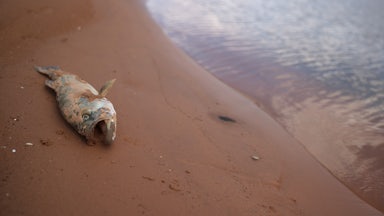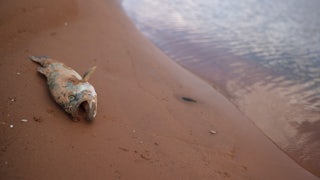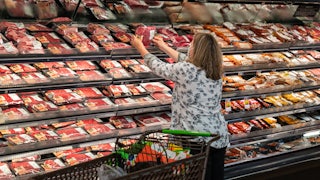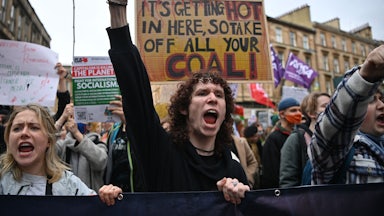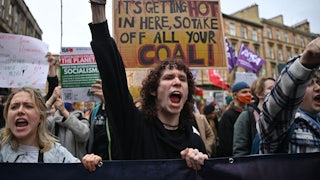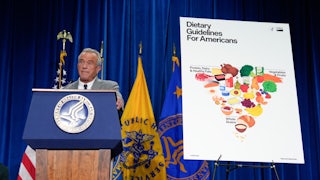To appreciate the complicated links between water, energy, and food, consider the many possible careers for a single water droplet. Humans could choose to burn coal in a power plant to heat the water into steam and spin a generator. Or we could take the water from a reservoir or underground aquifer and dump it on thirsty crops, which we then feed to ourselves or our livestock—or turn into biofuels. We could inject the water deep into the earth to cause cracks in shale rock, allowing natural gas to escape to the surface, where we capture that gas and use it to power tractors or water desalination plants, or turn the gas into fertilizer to help grow more crops.
This water-energy-food nexus goes back centuries—maybe even to the first waterwheels around 100 BCE, which affected fishing downstream. But in the Western United States, the growing water crisis involving 1.8 million agricultural acres, and threatening the hydroelectric power generation capacity of the Hoover Dam, is highlighting the trade-offs between different types of water usage with unusual clarity. One way the crisis is exposing these trade-offs is by introducing people to the concept of the “virtual water trade.”
To understand the virtual water trade, let’s start with cows. In recent years, public attention and anger has grown over the way water in the rapidly drying Colorado River Basin is used to grow food for cattle, whose emissions are driving climate change, which is exacerbating this drought in the first place. And part of why people are irritated is that some of the water isn’t even going to American cows but rather Saudi dairy cows.
The farm that’s drawing the ire of Arizonans sits in La Paz County, west of Phoenix. It’s owned by a subsidiary of Saudi Arabia–headquartered Almarai, one of the largest dairy suppliers in the Middle East, which is leasing public land from Arizona and taking advantage of the state’s lax groundwater regulations to grow a water-intensive crop to feed cows living in a desert on the other side of the world. The land is being leased at such a suspiciously low price that newly elected Arizona Attorney General Kris Mayes ran, and won, on a platform to stop the “Saudi water grab.”
Of course, this one farm and the Saudi cows it feeds are not the sole reason Western water supplies are under pressure; most hay and alfalfa stays in the U.S. Yet they have helped highlight what’s driving water scarcity around the Colorado River—and it’s not the lawns that cities like Las Vegas are ordering people to dig up and remove or the almond milk in millennials’ coffee. In the 17 Western states, 7 percent of water is used in people’s homes according to a recent study in Nature; commercial and industrial use account for another 5 percent. But a whopping 86 percent of water is consumed by crop irrigation, including the 32 percent of water used to grow crops that humans don’t even eat directly, such as alfalfa, hay, and corn silage for livestock.
By increasing water scarcity in the American West, climate change is making this inefficient transformation of water into human food increasingly intolerable. And conversely, with emissions from food production alone on track to send the world past 1.5 degrees Celsius (2.7 degrees Fahrenheit) of global warming, it is clear that the production of meat and dairy is increasingly unsustainable in a time of climate crisis. The states of the Colorado River Basin are trying to reach an agreement on how much water they should save, but California is holding out, so the federal government may have to step in and order water cuts.
The story of the so-called Saudi water grab is part of what academics call the “virtual water trade.” While some water is traded directly around the world—think Fiji flat or San Pellegrino sparkling—most traded water is actually embedded in other products, whether alfalfa, semiconductors (which require a lot of water for production), or something like a winter jacket, where water is used to drill and refine the natural gas that makes nylon and in the production of the electricity for processing it.
Virtual water flows save water on a global level because of comparative advantage: It wouldn’t make sense to grow alfalfa in parched Saudi Arabia, which is why the kingdom banned Saudi farmers from doing so in 2018 and started relying more on land in Arizona, California, and beyond. But that’s of little comfort on the local scale, when Americans from counties like La Paz are confronted with the trade-offs inherent in the water-food-energy nexus and have to forgo new housing construction because of the water shortage.
On a national level, the U.S. has relatively secure supplies of freshwater and is actually a net exporter of virtual water because of its huge agricultural exports. This virtual water trade is also multifaceted: U.S. consumption is responsible for the export of scarce virtual water from drier countries like Egypt, which grows the thirsty cotton that might end up in American bedsheets. Even though Egypt is water-scarce, it is also a net exporter of virtual water, with cotton, fruit, and vegetables being shipped to Japan, Europe, the U.S., and yes, Saudi Arabia, which receives 16 percent of Egypt’s virtual water exports. Perhaps understandably, Egyptians ship scarce water out to bring money in, rather than restricting their agricultural exports to save water for households or drinking. The Egyptian case fits with the finding that water “flows uphill toward money”: With each doubling of per-capita income, a nation increases its imports of fresh surface water and groundwater—embedded in other products—by 86 percent, according to a 2016 study. To make up for the water shortage, Egypt is planning to build new desalination facilities—which will use energy to produce water to enable the production of food.
The water-food-energy nexus has long been a topic for academics. But climate change, accelerating resource consumption, and globalization are bringing it home to everyone—and making it much harder to ignore the waste in certain trade-offs. If humans didn’t devote over three-quarters of global agriculture land to feeding animals that account for only 18 percent of global calories and 37 percent of the world’s protein, for example, it would be easier for eight billion people to live a good life on this planet. And while irritation about Saudis importing cow food is what got the water-food-energy nexus on the map in Arizona, it’s not just the international water trade or the meat industry that needs reexamining. Over 51 million acres of American land are used for growing corn and soy that is turned into biofuels—that’s more land than all the other types of energy production put together—and those crops need water too.
If choices have to be made in the era of climate change, there is a case for efficiency: plant-based or lab-grown meats instead of cow steaks, wind turbines instead of corn crops for ethanol, American homes instead of Saudi milk.

